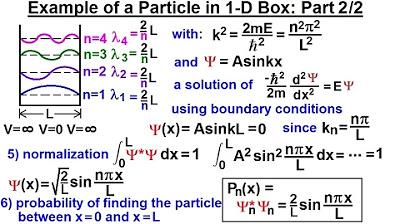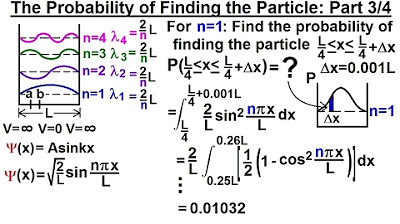Physics - Ch 66 Ch 4 Quantum Mechanics: Schrodinger Eqn (21 of 72) Prob. of Finding Particle 1
TLDRThe video script discusses the calculation of the probability of finding a particle in a one-dimensional infinite well within a specific range. It explains the process of squaring the wave function, integrating over the interval from 0 to 1/4 of the well's length, and applying the sine squared identity to simplify the integral. The result shows that there's approximately a 10% chance of finding the particle in the first and third quarters of the well, and about 80% in the middle half. This provides a clear understanding of the particle's likely locations within the well.
Takeaways
- 🌟 The video discusses calculating the probability of finding a particle in a one-dimensional infinite well within a specific range.
- 📝 The wave equation derived from the general concept is used to determine the probability by squaring the function and integrating over the interval of interest.
- 🔢 The probability is found by integrating the squared wave function from x=0 to x=L/4, where L is the width of the well.
- 🌀 The wave function for a particle in a one-dimensional well is sine squared in form, involving the variable nπx/L.
- 📌 The integration process simplifies by taking constants outside the integral and using the trigonometric identity for sine squared.
- 🧮 The integral of sine squared is transformed into an integral of (1 - cos(2nπx/L)) and then split into two parts for easier computation.
- 🏁 The first integral evaluates to L/4, and the second integral involves the cosine function, which simplifies the process.
- 📊 The final result of the probability calculation is 0.0908, or approximately 10%, for finding the particle in the first quarter of the well.
- 🔄 Due to symmetry, a similar 10% probability is expected for the particle to be found in the last quarter of the well.
- 🔴 The highest probability, around 80%, is calculated for finding the particle in the middle half of the well (from L/4 to 3L/4).
- 🎲 The problem demonstrates the application of wave functions, integration, and trigonometric identities in quantum mechanics.
Q & A
What is the main topic of the video?
-The main topic of the video is calculating the probability of finding a particle in a specific portion of a one-dimensional infinite well.
What is the equation derived for the particle in a one-dimensional well?
-The wave equation derived for the particle in a one-dimensional well is based on the general concept of what the wave equation should look like, and it is used to find the probability of the particle's location.
How is the probability of finding a particle calculated?
-The probability is calculated by squaring the wave function (since there's no imaginary part) and integrating it over the interval of interest, which in this case is from x=0 to x=L/4.
What is the significance of the sine squared function in the calculation?
-The sine squared function represents the squared wave function, which is used to calculate the probability density of the particle within the well.
How is the integral of the sine squared function evaluated?
-The integral of the sine squared function is evaluated using the trigonometric identity, which transforms it into an integral of (1 - cos(2nπx/L)) over the interval from 0 to L/4.
What is the role of the integral in determining the probability?
-The integral is used to sum up the probabilities over the interval from 0 to L/4, which gives the total probability of finding the particle within that interval.
Why is the constant factor 2/L taken outside the integral?
-The constant factor 2/L is taken outside the integral because it does not depend on the variable of integration (x), and this simplifies the integral expression.
What is the final probability of finding the particle in the first quarter of the well?
-The final probability of finding the particle in the first quarter of the well is approximately 10%.
How does symmetry contribute to the probability distribution in the well?
-Due to symmetry, the probability of finding the particle is about 10% in the first and third quarters, and about 80% in the middle half of the well.
What is the significance of the calculated probabilities for quantum particles in an infinite well?
-The calculated probabilities provide insights into the behavior of quantum particles within a one-dimensional infinite well, which is fundamental for understanding quantum mechanics and the properties of quantum systems.
How can the results from this video be applied in practical scenarios?
-The results can be applied in various areas of quantum physics, such as understanding the behavior of electrons in quantum dots or designing nanoscale electronic devices.
Outlines
🌟 Quantum Mechanics: Probability Calculation in an Infinite Well
This paragraph delves into the quantum mechanics concept of calculating the probability of finding a particle within a specific region of a one-dimensional infinite well. The discussion begins with a recap of previous videos on the particle's motion equation and the probability of finding it in an infinite well. The focus then shifts to the actual calculation of the probability for a particle to be found between x=0 and x=1/4L away from the left side of the well. The wave equation derived for the particle is used, and the process involves squaring the function, integrating over the interval of interest, and applying the sine squared function. The integration is carried out using the trigonometric identity, leading to a final expression that can be evaluated to find the probability.
📈 Probability Distribution in a Quantum Well: Interpreting the Results
The second paragraph continues the quantum mechanics discussion by interpreting the calculated probability distribution of a particle in a one-dimensional well. The calculation leads to a result that indicates a nearly 10% chance of finding the particle in the first quarter of the well (from 0 to L/4). Due to the symmetry of the system, a similar 10% probability is expected in the last quarter. The remaining 80% probability is associated with finding the particle in the middle half of the well (from L/4 to 3L/4). The arithmetic is worked out to provide a clear understanding of the probability distribution, which is a fundamental aspect of quantum behavior in such systems.
Mindmap
Keywords
💡Electron Line
💡Wave Equation
💡Probability
💡One-Dimensional Infinite Well
💡Wave Function
💡Sine Squared
💡Trigonometric Identity
💡Integration
💡Cosine Function
💡Quantum States
💡Symmetry
Highlights
Calculating the probability of finding a particle in a one-dimensional infinite well
Using the derived wave equation for the particle in the well
Squaring the wave function to find probability, due to the absence of an imaginary part
Integrating the squared wave function over the interval from 0 to 1/4 of L
Applying the integral of sine squared using the trigonometric identity
Integrating the expression to separate it into two parts
Evaluating the first integral to get 1/4
Evaluating the second integral involving the cosine function
Calculating the probability as 1/4 - (1/2 * pi) / (2 * pi * n)
Interpreting the result as approximately 10% probability of finding the particle in the first quarter of the well
Due to symmetry, a similar 10% probability is expected in the third quarter
An 80% probability of finding the particle in the middle half of the well
The method demonstrates a practical application of wave equations in quantum mechanics
The process illustrates the mathematical approach to solving quantum mechanical problems
The use of trigonometric identities simplifies complex integrals in physics
The video provides a clear step-by-step explanation of the calculation
The results have direct implications for understanding particle behavior in quantum wells
The explanation is accessible, making complex quantum mechanics concepts understandable
Transcripts
Browse More Related Video

Physics - Ch 66 Ch 4 Quantum Mechanics: Schrodinger Eqn (22 of 92) Prob. of Finding Particle 2

Physics - Ch 66 Ch 4 Quantum Mechanics: Schrodinger Eqn (20 of 92) Particle in 1-D Box: Example 2/2

Physics - Ch 66 Ch 4 Quantum Mechanics: Schrodinger Eqn (10 of 92) What is Normalization? Ex. 1

Physics - Ch 66 Ch 4 Quantum Mechanics: Schrodinger Eqn (23 of 92) Prob. of Finding Particle 3

Physics - Ch 66 Ch 4 Quantum Mechanics: Schrodinger Eqn (27 of 92) Expectation Value=? 1-D Box n=1

Physics - Ch 66 Ch 4 Quantum Mechanics: Schrodinger Eqn (25 of 92) Prob. of a Particle 1-D Box n=1
5.0 / 5 (0 votes)
Thanks for rating: